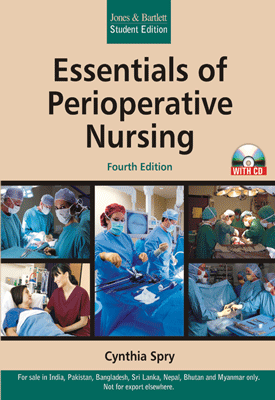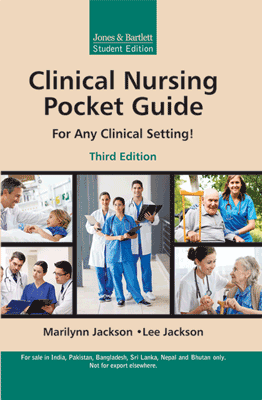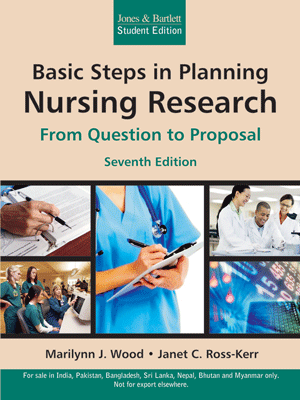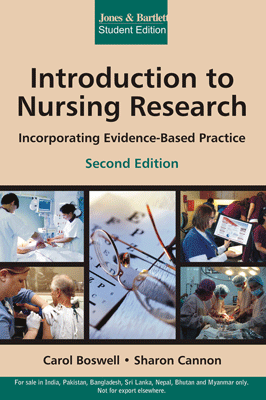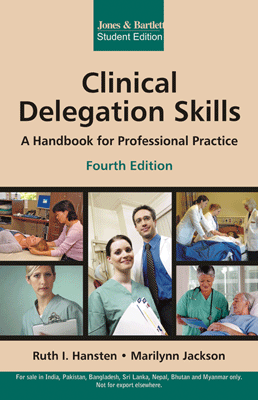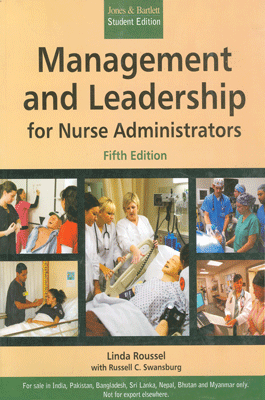Essentials of Perioperative Nursing, 4/e (With CD)
Essentials of Perioperative Nursing, 4/e (With CD)
₹405.00 ₹450.00 Save: ₹45.00 (10%)
Go to cartISBN: 9789380108797
Bind: Paperback
Year: 2011
Pages: 384
Size: 216 x 280 mm
Publisher: Jones & Bartlett Learning
Published in India by: Jones & Bartlett India Private Limited
Exclusive Distributors: Viva Books
Sales Territory: India, Nepal, Pakistan, Bangladesh, Sri Lanka, Bhutan
Key topics:
• An introduction to perioperative nursing
• Preparing the patient for surgery
• Prevention of infection, preparation of instruments and items used in surgery, and sterilization and disinfection
• Prevention injury
• Workplace safety
• A free CD- ROM is included containing questions to help readers prepare for certification
Target Audience:
The perfect resource for operating room nurses, nurses studying to become operating room nurses, current operating room nurses needing to refresh and test their knowledge, as well as colleges offering courses in perioperative nursing.
Contents:
Chapter 1: Introduction to Perioperative Nursing • Phases of the Surgical Experience • Preoperative • Intraoperative • Postoperative • Nursing Process Throughout the Perioperative Period • Assessment • Nursing Diagnoses • Planning • Intervention • Evaluation • Perioperative Nursing Data Set • Patient Outcomes: Standards of Perioperative Care • Roles of the Perioperative Nurse • Expanded and Advanced Practice Roles • Practice Settings • Members and Responsibilities of the Surgical Team
Chapter 2: Preparing the Patient for Surgery • Nursing Diagnoses • Desired Patient Outcomes • Preoperative Preparation • Preoperative Assessment and Interventions • Overview • Sources of Patient Information • Assessment Parameters • Physiologic • Psychosocial • Nursing Diagnoses and Interventions • Preoperative Period • Intraoperative Period • Prevention of Wrong Site Surgery • Patient/Family Teaching • Communication of Relevant Patient Data
Chapter 3: Prevention of Infection - Preparation of Instruments and Items Used in Surgery: Sterilization and Disinfection • Definitions • Desired Patient Outcomes • Sterilization and Disinfection • Critical, Semicritical and Noncritical Items • Critical Items- Examples • Semicritical Items- Examples • Noncritical Items-Examples • Sterility Assurance Level (SAL) • Disinfection • Methods of Sterilization • Overview • Thermal Sterilization-Steam Under Pressure: Moist Heat • Advantages • Disadvantages • Steam Sterilizers-Autoclaves • Overview • Gravity Displacement • Prevacuum Sterilizer (Dynamic-Air-Removal) • Bowie-Dick Test • Steam- Flush- Pressure-Pulse Sterilizer • Flash Sterilization • Chemical Sterilization-Ethylene Oxide Gas (EO) • Description • Advantages • Disadvantages • Chemical Sterilization-Low-Temperature Hydrogen Peroxide Gas Plasma • Description • Advantages • Disadvantages • Chemical Sterilization-Liquid Peracetic Acid • Description • Advantages • Disadvantages • Other Emerging Sterilization Technologies • Sterilization-Quality Control • Overview • Physical Monitors • Chemical Indicators • Biological Monitors • Rapid Readout Biological Monitors • Record Keeping • Disinfection • Overview • Levels of Disinfectants-Application • Glutaraldehyde • Ortho-phthalaldehyde • Disinfection-Quality Control • Documentation
Chapter 4: Prevention of Infection - Preparation of Instruments and Items Used in Surgery: Cleaning, Packaging, and Storage • Definitions • Nursing Diagnosis-Desired Patient Outcomes • Nursing Responsibilities • Preparation of Items and Instruments for Sterilization • Cleaning • Intraoperative Cleaning • Postoperative Cleaning • Manual Cleaning • Mechanical Cleaning • Special Protocols • Eye Instruments • Instruments Exposed to Prions • Flexible Endoscopes • Robotic Instruments • Ultrasonic Cleaning • Lubrication • Inspection • Packaging Materials- Barriers • Selection Criteria • Types of Packaging • Overview • Woven Fabric • Nonwoven Materials • Plastic/Paper, Plastic/Yvek - Pouches • Rigid Containers • Principles of Packaging-Steam • Instruments • Other Items • Basins, Bowls, Cups • Rubber Goods, Tubing, Items with a Lumen, Wood Items • Reusable Textiles- Linen Packs • Packaging for Alternate Methods of Sterilization • Package Information and Identification • Chemical Indicators • Sealing • Labels • Shelf Life • Storage Considerations • Determining Factors • Reuse of Single-Use Devices
Chapter 5: Prevention of Infection - Aseptic Practices: Attire, Scrubbing, Gowning, Gloving, Draping, Prepping, Creating and Maintaining a Sterile Field, OR Environment, and Sanitation • Nursing Diagnosis- Desired Patient Outcomes • Nursing Responsibilities • Pathogenic Microorganisms • Sources of Infection (Endogenous) • Patients • Sources of Infection (Exogenous) • Personnel • Environment • Equipment • Standard and Transmission-Based Precautions • Control of Sources of Infection • Control of Patient Sources of Infection-Skin Prep • Control of Personnel Sources of Infection • Attire • Scrubbing, Gowning, and Gloving • Definitions • Traditional Surgical Hand Antisepsis (Traditional Scrub Procedure) • Use of Alcohol-Based Hand Rubs • • Gowning and Gloving Procedure • Assisting Others to Gown and Glove • Creating a Sterile Field • Draping • Draping Guidelines • Standard Drapes • Maintaining a Sterile Field • Control of Environmental Sources of Infection • Traffic Patterns • Operating Room Environment • Operating Room Sanitation • Additional Considerations-Cleaning and Scheduling • Special Considerations
Chapter 6: Prevention of Injury - Positioning the Patient for Surgery • Overview • Desired Patient Outcomes • Impact of Surgical Positioning • Overview of Injuries • Respiratory and Circulatory System Compromise • Neuromuscular Injury • Facial Nerves • Brachial Plexus • Lower Extremity Nerves • Integumentary System Injury • Responsibilities of the Perioperative Nurse • Patient Advocate • Nursing Considerations • Patient Assessment • Planning Care • Additional Considerations for Positioning • Surgical Procedure • Anesthesia • Patient Dignity • Positioning Devices • Implementation of Patient Care • Transportation and Transfer • Initial Position • Techniques • Basic Surgical Positions • Supine (Dorsal Recumbent) • Trendelenburg • Reverse Trendelenburg • Lithotomy • Sitting (Semisitting, Semi-Fowler's, Lawnchair) • Prone • Jackknife (Kraske's) • Lateral • Positioning the Morbidly Obese Patient • Evaluating Implementation of Positioning • Postoperative Transfer • Documentation of Nursing Actions
Chapter 7: Prevention of Injury-Counts In Surgery • Description • Nursing Diagnosis-Desired Patient Outcome Overview • Nursing Responsibilities • Count Procedures • Sponge Counts • Sharps and Miscellaneous Items Counts • Instrument Counts • Documentation
Chapter 8: Prevention of Injury • Hemostatis, Tourniquet and Electrosurgical Equipment • Hemostasis • Natural Methods of Hemostasis • Artificial Methods of Hemostasis • Chemical Hemostasis • Thrombin • Absorbable Gelatin • Oxidized Cellulose • Microfibrillar Collagen • Styptic • Mechanical Hemostasis • Instruments, Ties, Suture Ligatures, Ligating Clips • Bonewax • Pressure • Tourniquet • Overview • Nursing Diagnosis-Desired Patient Outcome • Nursing Interventions • Electrical Hemostasis-Electrosurgery • Overview • Electrosurgical Components • The Generator • The Active Electrode • The Dispersive Electrode • Application • Nursing Diagnosis-Desired Patient Outcomes • Desired Patient Outcome/Criteria • Nursing Interventions-Patient and Staff Safety • Electrosurgical Use During Endoscopic Surgery-Special Precautions • Ultrasonic Energy Devices • Overview • System Components • Tissue Effects • Technology Characteristics • Applications • Argon Beam-Enhanced Electrosurgery • Overview. • System Components • Application and Characteristics
Chapter 9: Prevention of Injury- Use and Care of Basic Surgical Instrumentation • Nursing Diagnosis Desired Patient Outcome • Overview • Evolution of Surgical Instruments • Proper Care an HandlingDepartmental Impact • Manufacture of Surgical Instruments • Nursing Responsibilities Related to Surgical Instrumentation • Categories of Instruments • Cutting and Dissecting Instruments • Clamps • Hemostatic Clamps • Noncrushing Vascular Clamps • Occluding Clamps • Grasping and Holding Clamps • Grasping Forceps • Retractors • Suction • Other • Care and Handling • Cleaning • General Guidelines for Care and Cleaning • Inspection
Chapter 10: Prevention of Injury- Wound Management • Nursing Diagnoses-Desired Patient Outcomes • Potential Injury • Desired Patient Outcomes/Criteria • Surgical Wounds • Surgical Wound Classification • Wound Healing • Primary, Secondary, and Tertiary Intention or Delayed Primary Closure Process of Wound Healing • Suture Material • Classification of Suture Material • Monofilament and Multifilament • Absorbable Suture • Nonabsorbable Suture • Suture Diameter • Suture Selection-Considerations • Suture Package Information • Surgical Needles • Needle Characteristics • Needle Attachment • Other Wound Closure Devices • Stapling Devices • Skin Tapes and Skin Adhesives • Surgical Mesh • Drains • Dressings • Nursing Responsibilities Related to Wound Management
Chapter 11: Prevention of Injury- Anesthesia and Medication Safety • Potential Injury-Desired Patient Outcomes • Nursing Diagnoses • Desired Patient Outcomes • Outcome Criteria • Overview of Nursing Responsibilities • Preanesthesia • Assessment Data • American Society of Anesthesiologists Classification • Patient Teaching • Patient Instructions • Selection of Anesthetic Agents and Technique • Anesthesia Techniques-Overview • Premedication • Goals • Medications/Protocols • Monitoring • Practice Recommendations and Standards • Monitoring Devices • Precordial or Esophageal Stethoscope • Electrocardiogram (ECG) • Pulse Oximetry • Blood Pressure • Temperature • Capnography • General Anesthesia • Inhalation Agents • Anesthesia Machine • Intravenous Agents • Barbiturate Induction Agents • Nonbarbiturate Induction Agents • Dissociative Induction Agent • Narcotics • Tranquilizers- Benzodiazepines • Neuromuscular Blockers (Muscle Relaxants) • Stages of Anesthesia • Preparation for Anesthesia-Nursing Responsibilities • Sequence for General Anesthesia-Nursing Responsibilities • Malignant Hyperthermia • Overview • Treatment • Nursing Responsibilities • Moderate Sedation/Analgesia • Overview • Nursing Responsibilities • Regional Anesthesia • Overview • Spinal • Epidural and Caudal • Intravenous Block (Bier Block) • Nerve Block • Local Infiltration • Topical • Regional Anesthesia-Nursing Responsibilities • Medication Safety • Overview • Responsibilities of Team Members
Chapter 12: Workplace Safety • Regulations • Standards and Recommendations • Occupational Safety and Health Administration (OSHA) • National Institute for Occupational Safety and Health (NIOSH) The Joint Commission • Job Safety Analysis • Physical Hazards • Fire • Electricity • Radiation • Lifting and Moving • Slips, Thips, and Falls • Head Injury • Chemical Hazards • Formaldehyde • Methyl Methacrylate • Waste Anesthetic Gases • Latex Considerations • Glossary • Index
About the Author:
Cynthia Spry has been a perioperative nurse for more than twenty-five years, with seven and a half years as an OR Educator and five years as a Director of Surgical Services. Currently, she is an International Clinical Consultant for Advanced Sterilization Products, a Johnson & Johnson Company.She provides consultation and education in sterilization, disinfection, and infection control in the United States and in many other countries. She is a Past President of the (national) Association of perioperative Registered Nurses (AORN) and in 2002 received the Association's highest award, The Award for Excellence in Perioperative Nursing.
